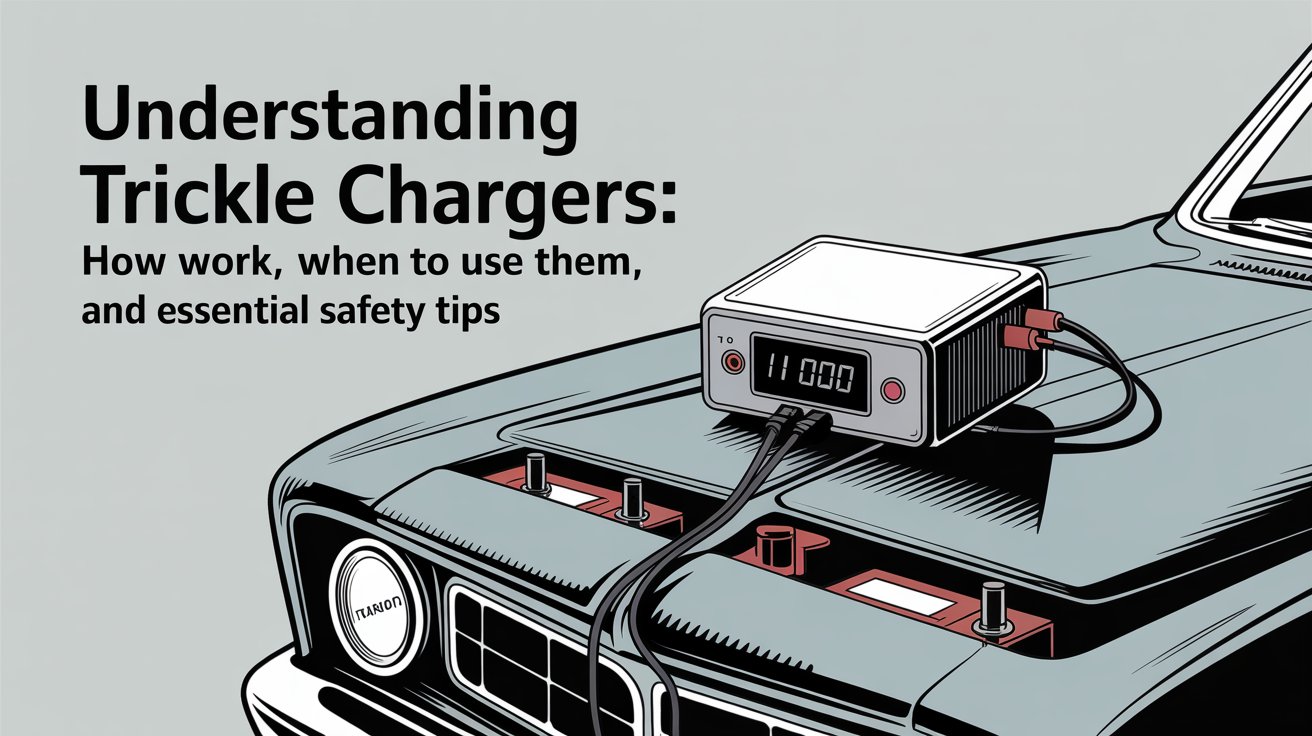Understanding Trickle Chargers: How They Work, When to Use Them, and Essential Safety Tips

Introduction
If you own a car, motorcycle, boat, or even a lawn tractor, one of the most frustrating problems is dealing with a dead battery. Vehicles that sit unused for weeks or months often refuse to start because batteries naturally lose charge over time. That’s where a trickle charger comes in. Many people wonder, what is a trickle charger, and do I really need one?
In this article, we’ll explain exactly what a trickle charger is, how it works, the differences between trickle chargers and other battery maintainers, and most importantly—when and how you should use one safely. By the end, you’ll have a complete understanding of this handy tool and whether it’s right for your battery maintenance routine.
What Is a Trickle Charger?
A trickle charger is a device that delivers a very small, steady stream of electrical current to a battery over an extended period. Unlike a regular car battery charger that may push 10 amps or more for quick charging, a trickle charger typically delivers just 1–3 amps—or even less.
The purpose is not to charge a dead battery quickly, but to counteract natural self-discharge that occurs when a battery sits unused. Think of it as a way to “top off” the charge continuously so the battery stays healthy and ready to go.
This is especially important for vehicles or equipment that sit idle for long periods, such as classic cars, motorcycles during winter, boats in storage, or backup power systems.
How Does a Trickle Charger Work?
The science behind a trickle charger is simple yet effective. All lead-acid and nickel-based batteries slowly lose their charge due to internal chemical reactions—even when they’re not connected to anything. This is known as self-discharge.
A trickle charger offsets that loss by supplying a current equal to or slightly higher than the battery’s self-discharge rate. This way, the battery remains fully charged without being overworked.
However, not all trickle chargers are created equal. Some are basic constant-current devices, which means they will keep pushing current indefinitely. If left unchecked, this can cause overcharging, leading to overheating, electrolyte loss, or reduced battery life. Modern trickle chargers often come with smart technology that monitors the battery and adjusts or shuts off the current automatically.
Trickle Charger vs. Maintainer vs. Float Charger
When researching, you’ll often hear terms like battery maintainer or float charger used alongside trickle charger. They may sound similar, but there are differences.
- Trickle Charger – Supplies a constant low current. Works well for short-term top-ups but can overcharge if left on too long without regulation.
- Battery Maintainer – Also called a smart charger, this type automatically cycles on and off, keeping the battery charged without risk of damage. It’s generally safer for long-term storage.
- Float Charger – Holds the battery at its ideal “float voltage” indefinitely, preventing overcharging while maintaining full charge.
In short, a basic trickle charger requires supervision, while a maintainer or float charger is designed for long-term connection without worry.
When Should You Use a Trickle Charger?
Now that you know what a trickle charger is, the next question is when to use one.
Ideal Situations
- Seasonal Storage: Perfect for motorcycles, ATVs, boats, or lawn tractors stored for months.
- Classic & Collector Cars: Keeps batteries fresh in vehicles that are driven occasionally.
- Standby Equipment: Useful for backup generators or emergency equipment that must stay ready.
When to Avoid It
- Dead Batteries: A trickle charger won’t revive a completely drained battery efficiently. For that, you need a regular multi-stage charger.
- Lithium Batteries: Traditional trickle charging is not suitable for lithium-ion batteries. These require chargers designed specifically for their chemistry.
- Unattended Use with Non-Smart Chargers: If your unit lacks automatic shutoff, leaving it plugged in long-term can damage the battery.
How to Choose the Right Trickle Charger
Not every charger fits every situation. Here are the key factors to consider:
- Amperage Output: Most trickle chargers supply between 1–3 amps. A motorcycle battery may only need 1 amp, while a car battery benefits from 2–3 amps.
- Voltage Compatibility: Common options are 6V for small engines and 12V for most cars. Always match your battery’s rating.
- Battery Chemistry: Standard trickle chargers are designed for lead-acid (flooded, AGM, GEL). Lithium-ion batteries require a compatible smart charger.
- Smart Features: Automatic shutoff, multi-stage charging, and temperature compensation add safety and convenience.
Safe Setup and Best Practices
Using a trickle charger correctly ensures both your safety and your battery’s longevity. Here’s how:
- Check Compatibility – Confirm your battery’s voltage and chemistry before connecting.
- Proper Connection Order – Attach the positive (red) clamp to the positive terminal, then the negative (black) clamp to the negative terminal or ground point.
- Plug in Last – Always connect the charger to the battery before plugging it into a wall outlet.
- Monitor When Necessary – If you’re using a basic trickle charger, check periodically for signs of overheating or overcharging.
- Use Smart Chargers for Long Storage – If you plan to leave the battery unattended for months, opt for a maintainer with automatic shutoff.
FAQs About Trickle Chargers
Is a trickle charger safe to leave on all the time?
Yes, but only if it’s a smart trickle charger or maintainer. Basic chargers can overcharge if left indefinitely.
What amperage should I use?
For maintenance, 1–3 amps is ideal depending on battery size. Higher amperage is unnecessary and can cause damage over time.
Can a trickle charger charge a dead battery?
Not effectively. Trickle chargers are for maintaining, not reviving. Use a standard charger to bring a dead battery back first.
Can I trickle charge lithium batteries?
No. Lithium batteries should only be charged with chargers specifically designed for them.
Which is better for storage, trickle or maintainer?
A maintainer is generally safer because it prevents overcharging automatically.
Common Mistakes to Avoid
Even with something as simple as a trickle charger, there are pitfalls:
- Overcharging Flooded Lead-Acid Batteries – Leaving a constant-current trickle charger connected too long can cause electrolyte loss and shorten lifespan.
- Using the Wrong Mode for AGM/GEL – These sealed batteries need voltage regulation. Using the wrong charger setting can cause permanent damage.
- Forgetting Parasitic Loads – If a vehicle has devices that slowly drain power, a weak trickle charger may not keep up, leaving you with a partially charged battery.
Alternatives to Trickle Chargers
If you’re not sure a trickle charger is the best choice, here are alternatives:
- Solar Maintainers – Great for outdoor storage where AC outlets aren’t available.
- Smart Maintainers with Diagnostics – Some advanced chargers not only maintain but also test and recondition batteries.
- Battery Disconnect Switches – In some cases, simply isolating the battery during storage is enough to prevent discharge.
Conclusion
So, what is a trickle charger? It’s a simple yet effective device that keeps your battery from going flat during long periods of inactivity. By delivering a steady, low current, it offsets natural self-discharge and ensures your vehicle starts right up when you need it.
For short-term top-ups, a traditional trickle charger works well. But for long-term storage, a smart maintainer or float charger is the safer bet. Always match your charger to your battery’s chemistry, follow safe setup practices, and monitor charging when necessary.
With the right approach, a trickle charger can extend the life of your batteries, save you from unexpected dead starts, and give you peace of mind during every season of storage.
Do Read: Complete Guide to iTop VPN Premium Account for PC in 2025







